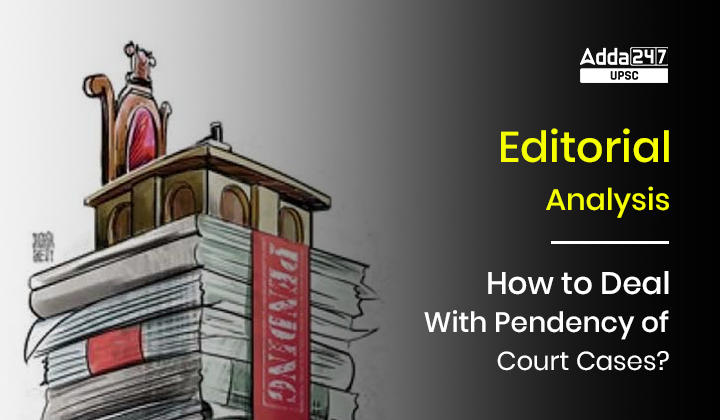Table of Contents
What is the Relevance of Today’s Editorial Analysis for UPSC?
Today’s editorial is based on the Issue of Pendency of Court Cases in our Country. Pendency of Court Cases is one of the biggest problem our Judicial System has been facing. This editorial brings some practical solutions to resolve this issue. It covers GS 2: Judiciary, Judicial Review for UPSC CSE Mains Examination.
Why in News?
- Recently, the Chief Justice of India D.Y. Chandrachud has said that the pendency of Court Cases is a perennial drawback that affects the court’s role as the timely protector of citizens’ rights.
- He also highlighted that the very purpose of the Supreme Court is to hear every little cry for personal liberty and protection of fundamental rights.
- D.Y. Chandrachud also stated that increasing the number of judges will not demolish the perennial problem of pendency, and that it is difficult enough now to find good High Court judge material.
The Working of Supreme Court Collegium
COVID-19 Associated pendency of cases?
- The COVID-19 pandemic had an acute effect on the Indian judiciary, increasing the pendency of cases in district courts by over 13 per cent in 2020, according to an analysis by Vidhi Center for Legal Policy, an independent legal research think tank. This was the highest such pendency since 2013.
- While the apex court proceeded at a reduced capacity, high courts had to temporarily shut down along with the district courts under their jurisdiction.
- The Supreme Court announced its decision to begin conducting virtual hearings through video conferencing March 23, 2020.
- It took the courts some time to determine how to quickly adopt technological solutions to ensure accessibility to the institution.
- The judiciary of every state adopted different measures to utilise their limited capacity optimally.
What is Supreme Court’s Jurisdiction Under Article 142?
How to Deal With Pendency of Court Cases?
Sushil Kumar Modi, Chairman of Parliament’s Standing Committee on Law and Justice has called for out-of-the-box thinking to solve the problem of Pendency of Court Cases. Here are three solutions which are doable, do not cost much, and yield solutions:
To extend Tenure of Existing Judges
- How to take best from H.C. Judges?: To Continue take services from existing High Court Judges as ad-hoc judges (after 62 year completion) which are experienced and more able than young judges.
- How to deal with huge SLPs?
- To bring back retired Supreme Court judges as ad-hoc judges to hear admission of Special Leave Petitions. These are appeals filed in hundreds every week against all kinds of orders of lower courts and tribunals across the length and the breadth of the country.
- They are the biggest clog to justice in the Supreme Court (SC) because they take away half the time of the country’s senior most judges in just reading these mountainous files to decide which minute fraction to hear and dismiss the rest.
- This will enable the current judges to take up important cases in adequate Bench strength and composition.
- High Court senior advocates sit as judges: Extend this a little more and have a scheme by which experienced High Court senior advocates sit as judges once a week to hear matters from another State High Court. Many would sign up for the novel and contributing experience, and many would do an excellent job.
To Strengthen online justice
- How to cultivate online justice?:
- Enabling ad hocjudges to work online from home with minimum support staff is an excellent harness of human and technology resources; it will enable a vast number of cases to be disposed of.
- The environment too must have been relieved to be saved of carbon footprint.
Employ Mediation
- Mediation is Superior to Litigation:
- As a method of dispute resolution, mediation is far superior to litigation in cases where it can be applied.
- Those cover a wide range, from personal and matrimonial to civil and commercial and property disputes.
- India has had a marvellous introductory run with this process; in less than 20 years it has firmly established itself in the court annexed mediation schemes with thousands of trained and enthusiastic lawyers and other mediators handling lakhs of cases.
- Mediation should be primary policy:
- Singapore’s Chief Justice Sundaresh Menon says, “What’s not to like about mediation?” It is a no-brainer to use mediation as a central peg of reform.
- What is necessary, however, is to devise and implement sensible policies and strategies to encourage resort to it; and principal amongst these is to make it a professionally attractive career option for mediators who are willing to make a living by being peacemakers.
- Indian Mediation Service:
- Indian Mediation Service can be created on the lines of the judicial service.
- And both incentives and disincentives must be devised for existing and prospective litigants to try this consensual method in good faith.
Issues in the Collegium’s Functioning
Conclusion
If well planned and executed, we have the capacity to lift half the load of Pending cases off court dockets. We just need to apply some practical out of the box solutions like appointing ad-hoc judges, developing e-Justice system and bringing parties to mediation tables.
FASTER system of Supreme Court
You may also find these Useful:
(Recent Editorial Analysis by our team at Adda247)




 TSPSC Group 1 Question Paper 2024, Downl...
TSPSC Group 1 Question Paper 2024, Downl...
 TSPSC Group 1 Answer key 2024 Out, Downl...
TSPSC Group 1 Answer key 2024 Out, Downl...
 UPSC Prelims 2024 Question Paper, Downlo...
UPSC Prelims 2024 Question Paper, Downlo...
